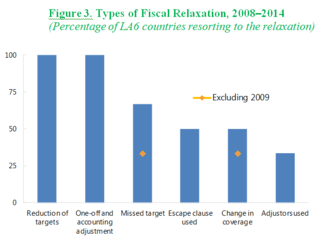Posted by Bogdan Lissovolik and Marcos Poplawski-Ribeiro[1]
Latin America’s countercyclical response to the 2008–09 global financial crisis (GFC) was the right medicine at the time, but resulted in a significant fiscal stimulus that it has yet to be fully withdrawn. Does this mean that the fiscal institutions established in the region before the crisis were not the Holy Grail to enshrine discipline? A recent study sheds light on this question by looking at the performance and design of fiscal institutions in six large Latin American countries (LA6: Brazil, Chile, Colombia, Mexico, Peru, and Uruguay). Overall, the crisis revealed both strengths and weaknesses in the fiscal frameworks in the LA6, underscoring the perils of making discretionary changes in fiscal policy without a medium-term anchor.
Latin America’s fiscal institutions bloom
Fiscal institutions in the LA6 blossomed in the decade prior to the GFC. These countries adopted many institutional “best-practices”—such as numerical fiscal rules, caps on sub-national borrowing or expenditure, medium-term budget frameworks, top-down budgeting, and stabilization funds—while strengthening fiscal transparency and budget management. Indeed, the LA6 countries compare favorably to their G-20 emerging peers in the “ex-ante” quality of budget institutions (Figure 1). But have these achievements actually translated into better fiscal policies?
Encouragingly, fiscal policies became more countercyclical in 2008–14 when compared to previous decades. However, much of this progress owes to fiscal relaxation during the 2008–09 crisis, while the experience in the 2010–14 recovery is mixed: there was little retrenchment as the spending-to-GDP ratios are still 4 percent of GDP above 2007 levels, on average. Did fiscal institutions affect these outcomes?
Fiscal rules: help or hindrance?
Numerical fiscal rules have been one of the cornerstones of the institutional reform in the LA6: all countries adopted some form of rule-based framework by 2006. With the exception of Chile, these were the so-called “first-generation” rules based on nominal budget balances or similar frameworks, in some cases complemented by expenditure rules. Prior to the GFC, compliance with the rules was high, with all countries meeting their key targets and objectives during 2002–07. Thus, unlike under previous economic booms, significant buffers were built by cutting public debt ratios, strengthening external reserves, and reducing balance sheet vulnerabilities, thereby enhancing credibility of fiscal frameworks.
The GFC, however, severely stressed those frameworks. For starters, a major countercyclical fiscal loosening was called for, given the unprecedented downturn. The accumulation of fiscal buffers—which was facilitated by the rules—helped to ameliorate market conditions and financing. But because of the relatively rigidity of those same rules in most countries—with the partial exceptions of Chile (which already had a structural balance anchor) and Peru (which had an escape clause)—such relaxation could not be achieved within the framework. Hence, as the crisis unfolded, most of the LA6 countries had to resort to ad-hoc adjustments to allow for the needed response (Figure 2).
The relatively robust recovery that followed, in turn, argued for reversing the stimulus, in line with the letter and spirit of the original rules. Instead, the 2009 relaxation of the fiscal frameworks became essentially permanent in many LA6 countries, though some countries fared better than others. In particular, there was insufficient effort to re-anchor medium-term fiscal objectives and, in some cases, a further weakening in policies. Such relaxation occurred via ad-hoc adjustments to the rules, such as missing the targets or continued use of exceptions or one-off operations (Figure 3), which our study documents in detail.
A number of design problems contributed to the drift. First, the reliance on nominal (as opposed to structural) rules imparted a pro-cyclical bias. The fiscal targets were also too easily changed; the escape clauses were lacking or were not fully comprehensive; and the coverage of the fiscal rules was often too narrow. Broader institutional issues, such as insufficiently independent fiscal expertise, and imperfect budget execution controls and multi-year budget frameworks contributed as well.
Nevertheless, several LA6 countries have moved to repair and re-anchor their frameworks and strengthen fiscal institutions in recent years.
Drawing lessons
Overall, our findings suggest that, in order to work, fiscal institutions need to be both appropriately designed and complied with. From that perspective, our study points to several good practices that could bolster the rules and institutions:
- Adjusting for the cycle by targeting a structural balance (correcting for the cycle and, if warranted, for commodity prices). In some cases, expenditure rules could be a more viable option to limit pro-cyclicality, given the difficulties of estimating the cyclical position;
- Ensuring broad and stable coverage of the rules to eliminate loopholes;
- Adding well-defined escape clauses, which provide reasonable flexibility in (truly) exceptional circumstances;
- Establishing, as capacities in the country allow, operationally independent fiscal councils to provide an objective public assessment of budgetary forecasts and monitor compliance with rules;
- Creating a medium-term expenditure framework, to account for and better manage the multiyear effects of policies; and
- Strengthening mechanisms to save windfalls from commodity-related revenues, including through the operation of a commodity stabilization fund.
References
International Monetary Fund, 2014, “Budget Institutions in G-20 Countries: An Update,” IMF Policy Paper, (Washington).
Celasun, O., F. Grigoli, K. Honjo, J. Kapsoli, A. Klemm, B. Lissovolik, J. Luksic, M. Moreno-Badia, J. Pereira, M. Poplawski-Ribeiro, B. Shang, and Y. Ustyugova, 2015, “Fiscal Policy in Latin America: Lessons and Legacies of the Global Financial Crisis” IMF Staff Discussion Note SDN/15/06, International Monetary Fund, April.
[1] Bogdan Lissovolik is a Senior Economist in the Western Hemisphere Department, IMF; Marcos Poplawski-Ribeiro is an Economist in the Research Department, IMF.
Note: The posts on the IMF PFM Blog should not be reported as representing the views of the IMF. The views expressed are those of the authors and do not necessarily represent those of the IMF or IMF policy.









